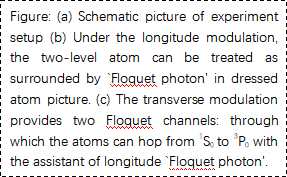The usage of battle ropes is highly related to the relative phase between two waves, such as alternative and double ways. Similarly, researchers doubly modulate one of the most accurate platforms – optical lattice clock [1], and observe the relative phase can strongly affect the ultra-cold quantum systems.[2] The Strontium atoms are cooled down to 3 micro-Kelvins and trapped in the optical lattice, and the outermost electrons can jump to higher energy level by absorbing a photon with matched energy. When periodically modulating the lattice laser, the two-level atom can be treated as surrounded by quantum quasi-particle ‘Floquet photons’, so that the transition can happen with assistant of ‘Floquet photons’ [3-4]. Meanwhile, if additional modulation is introduced, the relative phase between double modulations can bring the interference of ‘Floquet photons’. However, the phase of high frequency is extremely hard to stabilize, and the low frequency means the energy of ‘Floquet photons’ is too weak to observe. Thanks to ultra-narrow linewidth of optical lattice clock, the frequency can be set to hundred Hz, so the relative phase can be well tuned. In the experiment, the strong interference effect of ‘Floquet photons’ is clearly observed, and it can also be used to simulate the physics of topology in quantum materials. This work not only presents the first realization of double modulation in the ultra-cold atoms, but also opens up new avenues for quantum simulations.


This work strongly benefited from the close collaboration from the experiment group of Prof. Hong Chang in National Time Service Center (NTSC) of the Chinese Academy of Science (CAS) and the theory group of Prof. Xue-Feng Zhang in Chonqqing University. Recently, it is published in the prestigious scientific journal Physical Review Letters: Xiao-Tong Lu, Tao Wang, Ting Li, Chi-Hua Zhou, Mo-Juan Yin, Ye-Bing Wang, Xue-Feng Zhang, and Hong Chang “Doubly Modulated Optical Lattice Clock: Interference and Topology”, Phys. Rev. Lett. 127, 033601 (2021). As the co-first authors, Dr. X.-T. Lu contributes to the main part of the experiment and Dr. T. Wang dominates theoretical analysis.
[1] A. D. Ludlow, M. M. Boyd, J. Ye, E. Peik, and P. O. Schmidt Rev. Mod. Phys. 87, 637 (2015).
[2] X.-T. Lu, T. Wang, et al. Phys. Rev. Lett. 127, 033601 (2021).
[3] A. Eckardt, Rev. Mod. Phys. 89, 011004 (2017).
[4] M-J Yin, T. Wang, X.-T. Lu et al Chin. Phys. Lett. 38, 073201 (2021)